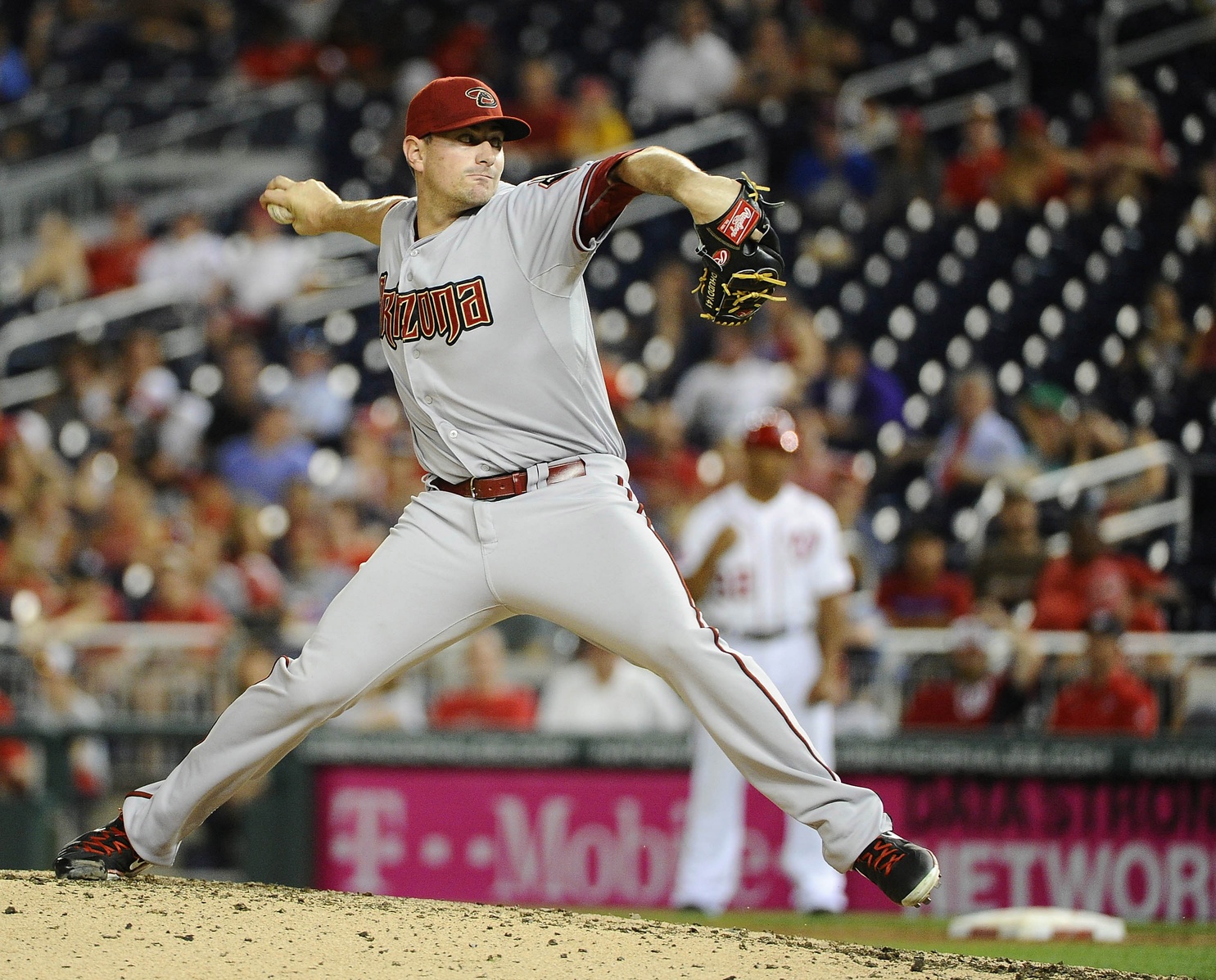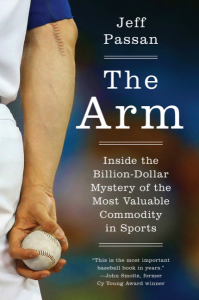The Arm: Inside the Billion-Dollar Industry of the Most Valuable Commodity in Sports by Jeff Passan.
In the prologue to The Arm, Jeff Passan asks two questions: “How did baseball fail the pitching arm?” and “What is being done to save it?” as a means to demystify the arm, primarily the ulnar collateral ligament (UCL), which he dubs a “finicky little bastard.”
To get to the heart of both questions, Passan relies on medical studies and comments from researchers and physicians to understand the science and the anatomy, as well as the history of arm troubles and treatments over the years. Part of the answer to his first question suggests that for decades, baseball didn’t understand or have the tools available to reliably figure out what caused arm troubles or how to treat them. He recounts stories of pain pills, elbow draining, and even removal of tonsils or teeth to relieve arm pain in the ’60s — the 1960’s.
Progress was slow until Tommy John met Dr. Frank Jobe, and Passan recounts John’s journey back from what had been – to that point – a career-ending injury: the torn UCL. The surgery pioneered by Jobe would take on John’s name in the parlance, and it was found to be a source of second life for pitchers.
Yet in a way, the procedure allowed baseball to continue to operate in ignorance of the sources of arm injury. As a former Baltimore Oriole notes to Passan, the approach by baseball was still reacting to injury rather than being proactive to find ways to prevent or limit damage.
This is where Passan gets into the heart of what the problems are — primarily a system of overuse that starts at youth levels as young as nine years old and continues through scout showcases, high school and travel ball (and other year-round travel circuits), and college. One 2015 research paper cited by Passan states that 58.6% of UCL procedures are performed on teenagers. Dr. James Andrews comments: “If they don’t get involved in it from a prevention standpoint at the youth level, they’re not going yo have anybody to draft out of high school or college who hasn’t had their elbow operated on.”
Teams have tried innings limits and pitch counts, and pitchers still can’t avoid injury. Still, without stronger answers, teams still hand out large contracts. Passan recounts the Chicago Cubs’ pursuit of left-hander Jon Lester and the due diligence that went into their decision to sign him. Even aware of the risks the six-year, $155 million contract offer to Lester held, the Cubs shrugged and crossed their fingers anyway. When solutions are absent, teams simply hope for the best.
Another fundamental issue – aside from overuse at the youth level – that Passan suggests is that baseball hasn’t made the “crucial investment in itself” yet to solve the elbow. Part of this problem is due to the league being slow to react, but also due to teams protecting their information as they seek answers themselves. One passage discusses Dr. James Buffi, who researched how the surrounding muscles might protect the UCL better. He’s all set to begin work with Driveline Baseball, an applied research and pitcher training facility. Then the Los Angeles Dodgers hired him away. Now, his research, insights, and breakthroughs go “directly into the Dodgers’ information silo.”
Not all hope is dashed, though. Passan also covers efforts by the league to answer the second question of what can be done about the injury epidemic, referring to the process by which Major League Baseball constructed HITS – the Health and Injury Tracking System – to examine concussions better, leading to the new(ish) 7-day disabled list. Another example from the HITS research led to a better understanding of hamstring injuries and information getting to teams to help prevent that injury. Passan believes the same research team can apply the same methods to learn more about treating arm injuries.
“Even one year’s worth of data immediately changed the way baseball operated,” Passan writes about the concussion studies enabled by HITS. Towards that information-gathering end, MLB and five teams are participating in a program that will follow players from the 2014 draft class for five years to “serve as a pilot program for vast data-gathering that soon could be standard for the sport.”
Passan also found examples of new technology used to measure the forces on the elbow to help catch warning signs, as well as new surgical techniques that could ease the rehabilitation process and speed up recovery of the injured players.
All of these efforts are geared towards getting players back on the field, and throughout The Arm, Passan shares the rehab stories of pitchers Todd Coffey and Daniel Hudson.
Following two players allows Passan to show the myriad stages a recovering player goes through and avoids getting trapped caring only about the “two days that matter” — the day of surgery, and the day of the player’s return. He puts a human story behind recovery from Tommy John Surgery and all the boring, grueling, frustrating aspects that it entails. On one hand, Coffey represents the player hoping for one last shot at the big leagues, convinced the whole way that his command will return, his velocity will return, and that he’ll get to take the mound again and take in the view of a big league stadium full of fans.
On the other hand, Passan’s portrayal of Hudson shows the doubt and depression that can come with recovery. Hudson’s case is particularly rare in that his ligament graft failed in his first pitching appearance after surgery, a circumstance that Passan says has happened only a handful of times. The level of access and intimacy in these moments allow Passan to provide his best moments in the book, showing how much work goes into the return, and hopefully dispelling the myths pitchers get better after TJS (something that has caused some youth players to request the procedure without any pain or injury to their UCL), or that that every player comes back quickly in the first place.
Along the way, Passan also explores how some (like Driveline and their most notable acolyte, Cleveland Indians pitcher Trevor Bauer) are trying to hack the body and find ways to add velocity and prevent injury. In this section, Passan tries to sift through the vast number of arm experts online and throughout the country, and also takes a glimpse at Japan, where notoriously high pitch counts are the norm and even a sense of pride, despite declining velocity and performance from youth pitchers who endure hundreds and hundreds of pitches in tournaments.
Overall, Passan’s experience as a national baseball writer makes The Arm a satisfying read. His passages tracking Hudson and Coffey capture the characters well and no doubt his day job helps get to the level of intimacy necessary for the reader to empathize with the monotony of pitchers during rehab. Passan covers the medical side well without getting too stuck in jargon, and his account of Coffey’s second Tommy John procedure reads like Dr. Neal ElAttache disarming a bomb in a spy novel.
There are shortcomings, though. While I found that many of the questions I’d scribbled in the margins were later answered in the book, I wanted more discussion of the biomechanics in the pitching motion than is present. Passan doesn’t ignore them and does go into some detail, but I wanted more.
While Passan does a great job of breaking down the youth showcases and their later impact on the UCL epidemic, he doesn’t go deeply into Latin America, where players often drop out of school just to play ball and many pitchers are signed at 16 years old. While Latin players are not immune to UCL tears, there isn’t much discussion given to how their youth workload compares to American pitchers’ youth workload, and what that means to the injury statistics.
The Arm is touted by John Smoltz as the “most important baseball book in years,” and the subject matter is certainly a major issue in the game today. Passan capably addresses both of the questions he aims to answer, and his anecdotes involving Coffey and Hudson bring forward the human side of injuries. The work is definitely important, but if it has the impact I think Passan hopes it has, in a few years it’ll read as a the first step towards what will eventually lead to solutions for youth and big league pitchers alike – and perhaps a follow-up from Passan.
Note: A review copy of this book was provided by the publisher.
HarperCollins publishers, 352 pages, $26.99 list price. Available online at Amazon and Indiebound, or at your local bookstore (ask them, they’ll order it.)


1 comment on “Book Review: “The Arm” by Jeff Passan”
Comments are closed.